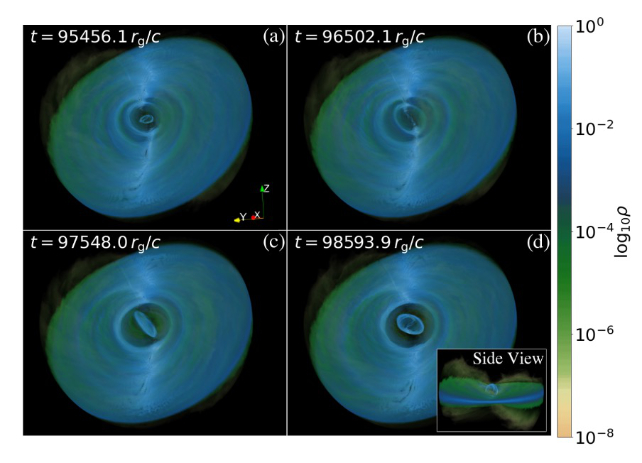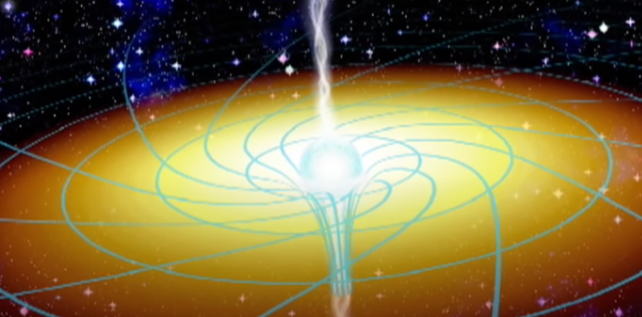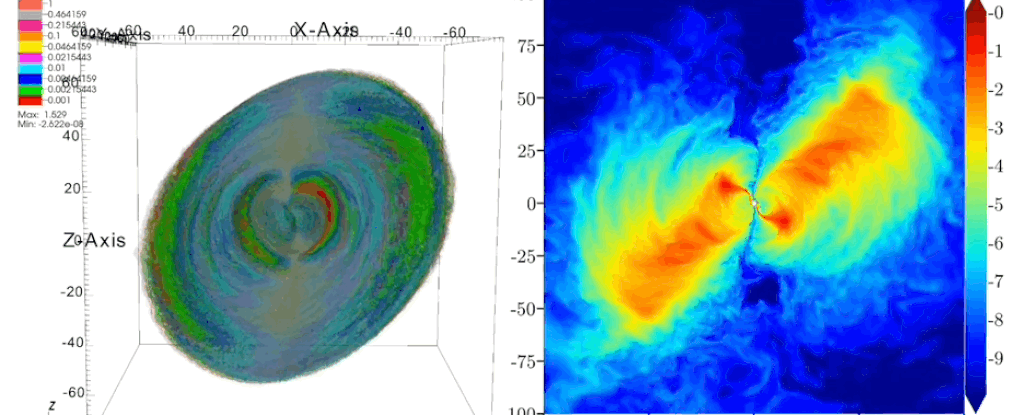A 3D model of a black hole's erratic feeding pattern reveals a potential explanation for the bizarre behavior of quasars with a dimmer switch.
It's highly unusual for galaxies to do anything in a hurry, but 'changing-look' quasars are an exception.
They can switch their jets of radiation on and off within mere years or even months. This disappearing act shocked astrophysicists when it was first observed in 2014, and continues to mystify scientists.
Sitting at the center of infant galaxies, quasars (or 'quasi-stellar radio sources') typically burn 27 trillion times more brightly than our Sun. Quasars are made up of a ravenous supermassive black hole and its meal: the gas and dust swirling around it in the accretion disc.
Past models assumed that matter orbiting a black hole would cross the event horizon in a relatively orderly manner, like water going down a drain. This was assumed to be a slow process that carried on for 10,000 years or more.
"For decades, people made a very big assumption that accretion disks were aligned with the black hole's rotation," says lead author Nick Kaaz, an astrophysicist at Northwestern University in the US.
"But the gas that feeds these black holes doesn't necessarily know which way the black hole is rotating, so why would they automatically be aligned? Changing the alignment drastically changes the picture."

When the team created a 3D computer model of a rotating black hole that was out of alignment with its accretion disc, weird things started to happen.
Instead of behaving like a pizza base being spun around a chef's finger, the accretion disc started to warp and tear apart.
It broke into an inner sub-disc and an outer disc, and each disc spun at a different tilt, much like a gyroscope.

This disk split was caused by the rotating black hole twisting the spacetime around it – a general-relativistic process called frame-dragging.
"When [black holes] rotate, they drag the space around them like a giant carousel and force it to rotate as well," says Kaaz.
Frame-dragging has a stronger pull on the material orbiting closer to the black hole and a weaker pull on the material orbiting further out.
This difference means the inner disk rotates faster than the outer disk.
At first, friction and pressure keep the disk together. But, eventually, the twisting of spacetime by the black hole causes the inner disk to break off into a separate disk that is smaller and therefore easier to move.
"The tearing region is where the black hole wins," says Kaaz.

These two disks are at odd angles to each other and collide, causing shocks. 'Streamers' from the outer disk rain down onto the inner sub-disk, forcing matter to be fed into the black hole faster.
This additional mass drives the inner disk toward the black hole to be swallowed, then the black hole's gravity draws gas from the outer region to replenish the inner region. These processes could shed light on why quasars can turn off and on abruptly.
"Classical accretion disk theory cannot explain this drastic variation," says Kaaz.
"But the phenomena we see in our simulations potentially could explain this. The quick brightening and dimming are consistent with the inner regions of the disk being destroyed."
This paper was published in The Astrophysical Journal.
